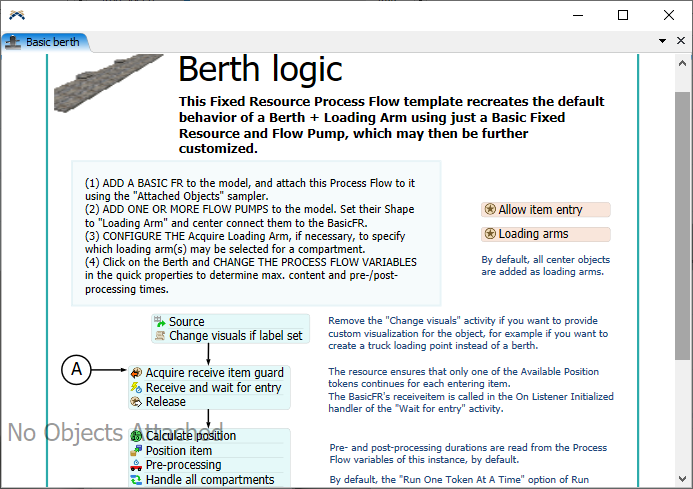Loading Point
Overview and Key Concepts
The loading point represents a location at which a loading or unloading operation takes place, such as a ship jetty or truck loading lane. There are three modes of operation for the loading point:
- Manual: Using a manually controlled loading time, where transporters remain in the (un)loading state until you manually call the
StopLoading()command on them. - Fixed time: Using a processing time sampled per transport for the load or unload operation, somewhat similar to FlexSim's processor for flow items, with an additional option to include pre- and post-loading processes.
- By tank level: In conjunction with a loading controller, such as a loading arm or multi-compartment loading controller. The (un)loading time is automatically determined by the flow to or from a flow tank on the loaded item (ship or truck) - the loading controller monitors the fluid level in the transporter's tank and notifies the loading point when the operation is complete.
The Berth is functionally equivalent to the Loading Point, except the visualization and queue placement of transporters in the loading point is by default aimed at truck transports while the default settings of the berth are specifically tailored towards flow vessels.


Process Flow Template
FloWorks provides a Process Flow Template that makes a Basic FR and a (set of) flow pump(s) mimick the basic behavior of a Loading Point with one or more loading arms connected. You can use this template in those cases where the built-in functionality of the loading point and loading arm are too restrictive, for example if you have complex berth assignment logic. The template can be added from the Process Flow button on the toolbar, in the FloWorks submenu, and contains instructions for using it in the Process Flow itself.

Events
The loading point and berth use standard events that are common to a fixed resource such as a Queue or Processor. See Fixed Resource - Events page. In addition it has the following events:
On Start Preprocessing
This function is called immediately before the preprocessing starts, after the preprocessing time has been sampled. If no preprocessing has been specified (preprocessing time 0) this function will still be called, but it will be immediately followed by OnStartLoading.
It has the following parameters:
| Event Parameter | Explanation |
|---|---|
| item | A reference to the flow item (transporter). |
On Start Loading
This function is called when the preprocessing time of a transporter has ended and the loading operation (whether timed or controlled by a loading controller) is about to start.
It has the following parameters:
| Event Parameter | Explanation |
|---|---|
| item | A reference to the flow item (transporter). |
On End Loading
This function is called immediately after the loading or unloading has finished, and immediately before the postprocessing step starts. If no postprocessing has been specified (preprocessing time 0) this function will still be called, immediately followed by On End Postprocessing.
It has the following parameters:
| Event Parameter | Explanation |
|---|---|
| item | A reference to the flow item (transporter). |
On End Postprocessing
This function is called when the postprocessing time of a transporter has completed and the item is released from the loading point. Even if no postprocessing has been specified (preprocessing time 0), this event will still fire.
It has the following parameters:
| Event Parameter | Explanation |
|---|---|
| item | A reference to the flow item (transporter). |
States
Loading point states for multi-item loading points
Note that no flow goes through a loading point, so this object does not have a FloWorks state profile. For statistical purposes, the loading point's FlexSim default state profile will be in one of the following states at various points during a simulation run:
Idle
The loading point is empty and is waiting for a transporter to enter.
Busy
The loading point is processing at least one transporter.
Loading point states for single-item loading points
If the loading point only accepts a single transporter because its capacity is set to 1, its state profile is more detailed:
Idle
The loading point is empty and is waiting for the transporter to enter.
Preprocessing
The loading point is in the preprocessing stage of the transporter.
Busy
The loading point is in the loading stage of the transporter: either the (un)load time is running or the loading point is waiting for the loading controller to release the item.
Postprocessing
The loading point is postprocessing the transporter.
Blocked
The loading point has released the transporter, and is waiting for it to exit. The output may be blocked by a downstream object or - in theory - the transporter may be waiting for an operator.
Flow item states set by the loading point
In addition to the state profile of the loading point itself, the loading point also changes the (default FlexSim state profile) state of the flow items it processes. Regardless of whether the loading point has a capacity of one or more, the following flow item states are applied while the flow item is under the loadig point's control:
Waiting
The transporter has entered the loading point but the "Max. simultaneous loading" capacity is reached so it has to wait before it can start preprocessing.
Preprocessing
The transporter is in the preprocessing state.
Busy
The transporter is being (un)loaded: either the (un)load time is running or the loading point is waiting for the loading controller to release the item.
Postprocessing
The transporter is being postprocessed.
Blocked
The loading point has released the transporter, which is now waiting to exit. It may be blocked by a downstream object or - in theory - waiting for an operator to pick it up.
Properties
The loading point object uses the following properties panels: